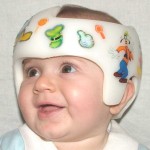Positional Plagiocephaly or Flattened Head in Babies
 Positional plagiocephaly means or describes a flattened or misshaped head. This may be caused due to crowding in the womb if the foetus does not get sufficient space to position itself. This may also be caused by making the child lie in one position for long hours. Some mothers make the child lie straight for a long time and this results in flattening of the head from the back. The head can get de-shaped due to a variety of causes, and is termed as plagiocephaly. The change of shape may also be caused by skull sutures closing soon, twisted neck at the time of birth and collection of fluid around brain.
Positional plagiocephaly means or describes a flattened or misshaped head. This may be caused due to crowding in the womb if the foetus does not get sufficient space to position itself. This may also be caused by making the child lie in one position for long hours. Some mothers make the child lie straight for a long time and this results in flattening of the head from the back. The head can get de-shaped due to a variety of causes, and is termed as plagiocephaly. The change of shape may also be caused by skull sutures closing soon, twisted neck at the time of birth and collection of fluid around brain.
Causes of flattened head in babies
The skull of the baby at the time of birth is made of several plates. The plates have space between them and continue to position to give shape to the head of the child and to grow in size as the brain grows. If during the initial period, when the child is dependent and unable to move on his own, the child is made to lie in one position, the part that is pressed gets flattened. The child may also develop this condition if kept tied for long time on the car seat or on bouncy seat.
Prevention
To prevent the occurrence of positional plagiocephaly, the child should be repositioned which will help relieve pressure from the back of the infant’s head as mostly they lie straight on the back. Other ways to prevent this are:
- Provide tummy time to the child. When the child is awake and someone is around to supervise him, the child should be made to lie on tummy. This will not only prevent flat head but also provide exercise to the neck and shoulder muscles. Tummy time should be tried 2 to 3 times a day for a short time to begin with. Once the baby gets used to this posture, he can be kept for a longer time and more frequently.
- Change the direction of the crib at regular intervals. This will encourage the baby to turn his head to the other side to observe the object he or she had been watching while the crib was in the other direction.
- Do not keep the baby for a long time in car seat or baby carrier.
- Hold the baby on your shoulder so that his head is free from all sides.
- To make the baby lie comfortably on his back, you can stitch a U shaped pillow for the child. This way a major portion of the head is free.
Generally no specific treatment is required to enable the baby to overcome this problem. Once the child is about half a year of age and starts sitting down or starts crawling, the flat spot will go away. If still corrective steps are required to be taken the doctor may get a helmet or corrective band made for the child. When the child wears any of these gadgets the pressure will be exerted on some parts of the head and the flat part will start to take shape, this treatment may continue for two to three months. In case the head is misshaped due to some other reasons, surgical repair may be recommended by the doctor.